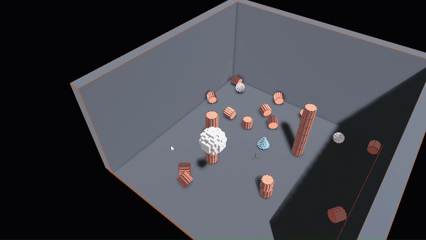The Algebra of Self: Modeling Personality and Progress
This article explores a way to mathematically model our inner lives. By using the framework of vector algebra, we can gain a powerful new perspective on how we make decisions, process advice, and evolve through our relationships.
Imagine your personality, skills, beliefs, and current circumstances as a single point in a vast, multi-dimensional space. We'll represent this current reality as your initial state vector \(\vec{I}\). Each dimension in this space is a trait—like honesty, fitness, or financial stability.
Your ideal future self—the person you aim to become—is your goal vector \(\vec{G}\).
The fundamental problem of life, in this model, is finding the perfect sequence of actions that transforms \(\vec{I}\) into \(\vec{G}\). We can represent this ultimate, ideal change as an unknown ideal transformation vector \(\vec{V}\):
\[\vec{I} + \vec{V} = \vec{G}\]
The Imperfect Art of Advice: Guessing the Transformation
Since we can't directly calculate the perfect vector \(\vec{V}\), our conscious brain must research, strategize, and make an educated guess vector \(\vec{X}\). This guess \(\vec{X}\) is the new habit we adopt, the book we read, or the advice we take.
We try to choose \(\vec{X}\) to be as aligned with the ideal \(\vec{V}\) as possible. In math, the measure of alignment between two vectors is the dot product, \(\vec{X} \cdot \vec{V}\).
- Optimal Guess: If \(\vec{X}\) is perfectly aligned with \(\vec{V}\), the dot product is maximized, and we make maximum progress toward \(\vec{G}\).
- Wasted Effort: If \(\vec{X} \cdot \vec{V} \approx 0\), the vectors are nearly orthogonal. Your action has no meaningful impact on your goal.
- Negative Progress: If \(\vec{X} \cdot \vec{V} < 0\), the vectors are opposing. Your action actually moves you farther away from your goal \(\vec{G}\). This is the risk of bad advice.
The Cost of Inertia
The good news is that this framework makes the need for action clear. If you never guess or never act (i.e., \(\vec{X} = \vec{0}\)), the dot product is zero, and you are guaranteed never to move toward \(\vec{G}\).
Action, even imperfect action, is the only way to generate a non-zero dot product and, therefore, the only path to progress.
Furthermore, if we attempt \(\vec{X}\) and realize we ended up farther away, we have learned something critical: we've ruled out that direction for our next guess. Life becomes an iterative optimization problem.
The Dimensionality Trap: Trade-offs in Transformation
Life goals are complex and high-dimensional. To make things easier, we often attempt to simplify the problem space.
If your goal \(\vec{G}\) is "to get fit," the ideal vector \(\vec{V}\) contains many components: "optimized nutrition," "consistent exercise," "adequate sleep," and "stress management." We often reduce this to a single, simpler guess, like \(\vec{X}\) = "run every morning."
This is effective, but it highlights the problem of trade-offs. Sometimes, a choice moves us closer to \(\vec{G}\) in one dimension while simultaneously pushing us backward in another.
Consider an individual starting at \(\vec{I} = (0, 0)\) (zero financial wealth, zero social life) who sets a goal of \(\vec{G} = (5, 5)\) (stable finances, rich social life).
They choose the action \(\vec{X} = (5, -20)\), which represents working non-stop to earn money while becoming completely isolated.
- The resulting state is \(\vec{I} + \vec{X} = (5, -20)\).
- The ideal vector required was \(\vec{V} = (5, 5)\).
In this scenario, one dimension (financial wealth) is spot on! However, the overall progress, measured by the dot product, is profoundly negative:
\[\vec{X} \cdot \vec{V} = (5, -20) \cdot (5, 5) = 25 - 100 = -75\]
A negative dot product means the action was largely counterproductive to the overall goal. This elegantly models the feeling of hollow success—perfect execution in one area resulting in movement away from the true \(\vec{G}\).
Relationships as Matrix Transformations
While personal habits are additive vectors, a major life experience or a deep relationship can be modeled as a matrix transformation \(M\).
A matrix doesn't just add; it can stretch, compress, or rotate the entire personality space.
\(\vec{I}_{\text{new}} = M \cdot \vec{I}_{\text{old}}\)
A transformative relationship (matrix \(M\)) might rotate your personality vector, fundamentally changing the relationship between your existing traits. For example, it might make you more ambitious, which then changes how your existing trait of resilience is expressed. The most stable, unchangeable parts of your character could even be viewed as the eigenvectors of this matrix \(M\)—traits that are only scaled, never directionally changed, by the relationship.
The Wisdom of Aggregation
This mathematical perspective is the ultimate argument against blindly following a single source of advice.
Since every person's initial state \(\vec{I}\) is different, the ideal path to the same goal \(\vec{G}\) is unique to the individual: \(\vec{V} = \vec{G} - \vec{I}\).
Relying on one person's successful vector \(\vec{X}_{\text{guru}}\), when their starting point \(\vec{I}_{\text{guru}}\) was completely different from yours, is a high-risk gamble.
The intelligent strategy is to aggregate advice from many sources, weigh them against your current state \(\vec{I}\), and formulate your own best-guess vector \(\vec{X}_{\text{best}}\).
By viewing self-improvement through the lens of linear algebra, we see life not as a mystery, but as a solvable, multi-dimensional optimization problem where calculated action and continuous learning are the only required inputs.


